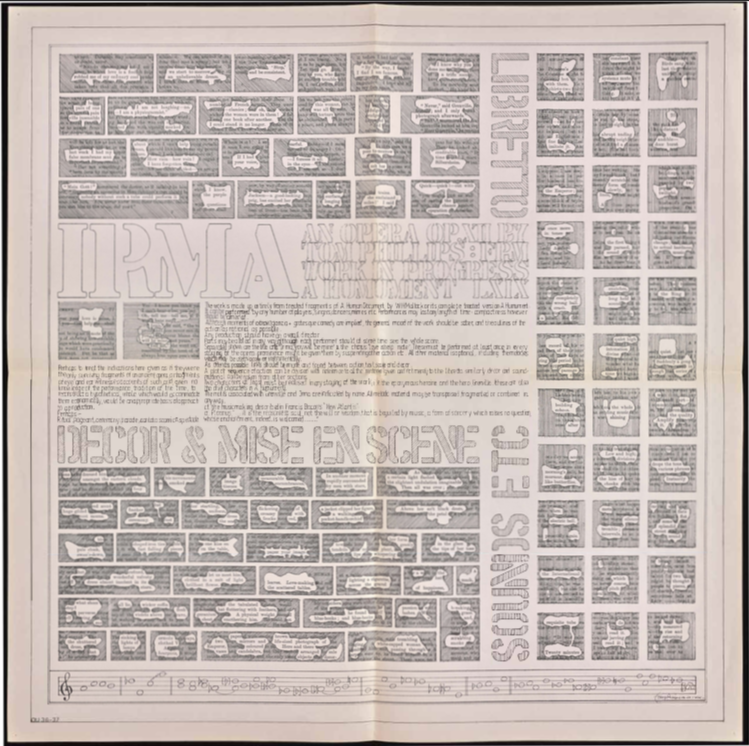
Irma |17 June 2019 | 7:30pm | Lumen Church
“Quick—
quick!
just a chance
the chance opera”
A skeptical heroine, a lovelorn philosopher, a wandering misfit.
The surviving heroes of a forgotten novel,
on a quest for one another and themselves.
About Irma
On the day the first human steps were taken on the moon (20 July 1969), Tom Phillips, a British artist (born 1937), completed Irma, an opera based on a Victorian novel by W. H. Mallock. Irma’s text is drawn entirely from fragments of Mallock’s A Human Document. Phillips published multiple editions of A Humument, his treatment of this text, over a period of fifty years. He cites the influence of William Burroughs and John Cage in his decision to apply cut-up methods to Mallock’s novel, which he had bought for threepence in 1966. In this sense, Irma is an authentic threepenny opera.
Irma was first published in 1970, in a small French avant-garde review (OU, edited by Henri Chopin). Readers were presented with a large sheet on which the treated fragments were labeled ‘LIBRETTO’, ‘DECOR & MISE EN SCENE’, and ‘SOUNDS ETC’. Phillips also included instructions, performance suggestions, and a group of melodies. His advice is ‘perhaps to treat the indications here given as if they were the only surviving fragments of an ancient opera, or fragments of eye and ear witnesses’ accounts of such, and given no knowledge of the performance tradition of the time, to reconstruct a hypothetical whole which would accommodate them economically, would be an appropriate basis of approach to a production’. Phillips also stipulates that ‘Irma, you will be mine’ and the chorus ‘love is help mate’ must be performed at least once in every staging of the opera.
According to Phillips, Irma grew out of the musical tradition of Cornelius Cardew and the Scratch Orchestra. The 50th anniversary of the publication of the Scratch Orchestra’s Draft Constitution, and of the 1969 version of Irma, led the Vocal Constructivists to reimagine Irma for 2019.

Scenes
| The Sylvan Ritual The Sacrifice Let Us Go Now Enter Toge The Mad Scene I Know the Purple Questions Dream Interlude Dance: a Dream Toge and his Friends The Brindisi | Dance: Toge and the Nurse The Surreal Parade Lesbia Waltz I Am Not Ten Past The Battle The Funeral Irma, You Will Be Mine Love Is Toge Abandons Love Love Is Help, Mate |
A Note from the Curators
Phillips created the Humument by ‘mining and undermining’ The Human Document. The Vocal Constructivists continue this process of excavation in their version of Irma, by collectively mining and undermining Phillips’ works, interweaving a multitude of perspectives. Three distinct incarnations of each Humument character—Irma, Grenville, and Toge—seek to connect with one another and with their own fragmented selves, encountering many other fleeting figures along the way. The principal characters each have their own instrumental accompaniment, drawn from our ensemble of analog synthesizers, sarangi (the Indian bowed instrument of 100 colours), theremin, (prepared) piano, alto flute, and tuba.

There is a short film of performance highlights:
